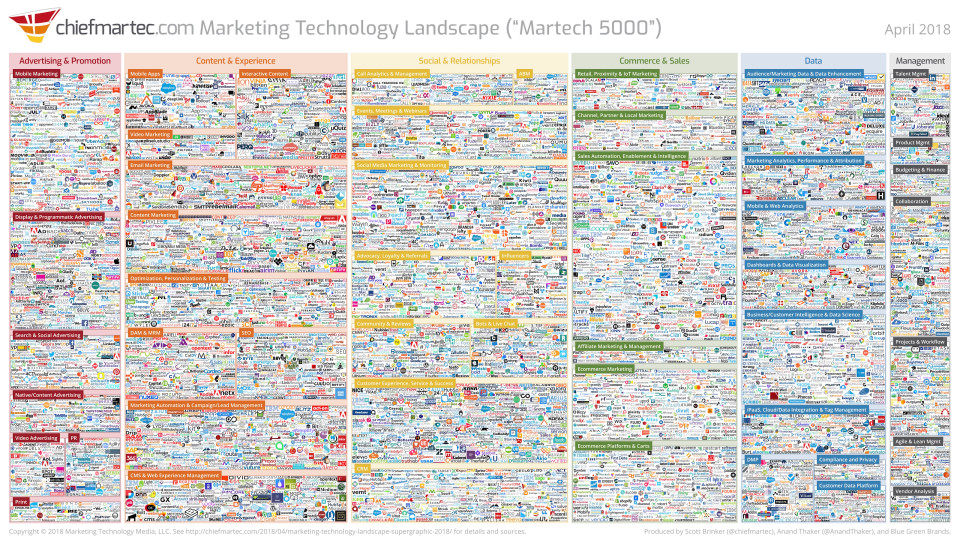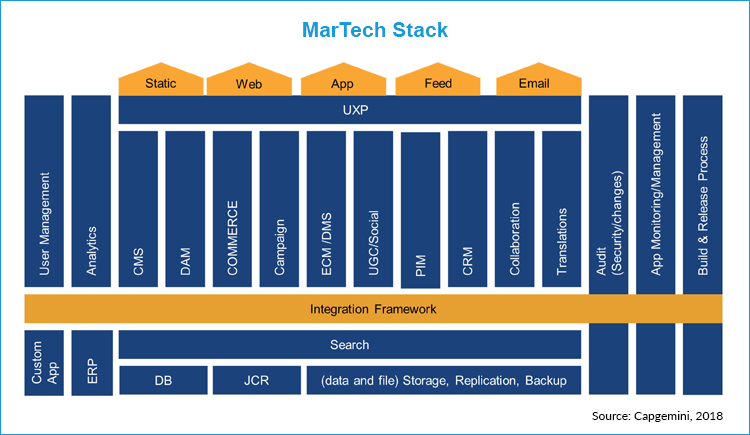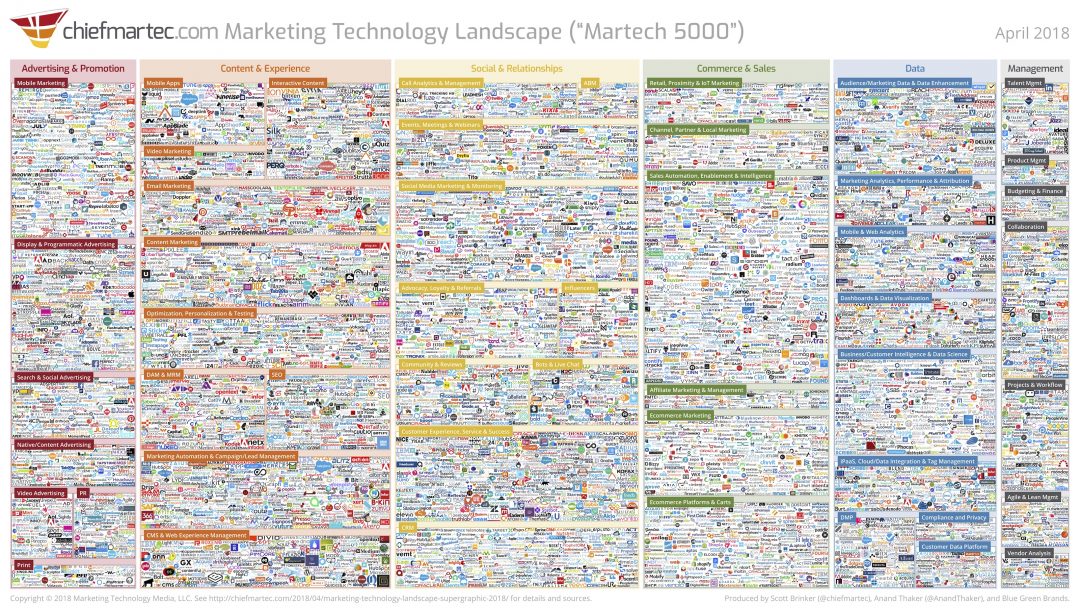Are you Being Strangled by your Stack?
Blog: Capgemini CTO Blog
Marketers have been spending their entire careers trying to get into the minds of customers and now, with the plethora of new technologies, your marketing organization finally has access to this holy grail of insight. But how do you know where to start? Which is the right platform, tool, or solution to use to best understand your customer?

You may have seen the MarTech 5000 supergraphic (pictured above) – whose name is already outdated. It’s a stunning display of the now almost7,000 solutions (from 6,242 unique companies) that are currently available to help your team better understand and manage the customer journey. That’s a lot of automation and intelligence at your disposal. (Fun fact: In 2011 you only had about 150 such solutions to choose from.)
But while the explosion of marketing solutions offers unprecedented opportunities, it’s now on you to identify the right MarTech investments. You not only have to think like a customer, and a salesperson, but you also have to think like a CIO to solve problems that feel very foreign:
- How can technology build on our existing infrastructure to create superior value for our customer and company?
- How can different sources of data (e.g., point of purchase, data warehouse, scanner, secondary sources, surveys, websites, searches, and social media) be integrated to provide holistic insight on the business?
- How should we define, specify, resource, integrate, and implement technology-enabled marketing solutions?
Meanwhile, the actual CIO and his/her team are tasked with reigning in costs. Their job is made ever more challenging as marketing and other business units make use of cloud-based applications. The IT department used to be the control center that could manage against duplication and siloed data. Now everyone’s a technologist, doing their own thing – and unwittingly creating inefficiency and barriers to key insights.
The MarTech Blueprint is the fundamental starting point to solving every one of these challenges.
Blueprint Basics
The MarTech Blueprint is a diagram or visual representation that illustrates how technologies connect and coincide to drive all or some marketing processes and outcomes. It can be detailed or visionary: developed as a schematic or an infographic. The format is less important than the exercise of mapping out the capabilities, performance, and impact each technology investment has or will have on organization.

Bringing Order To Chaos (And Harmony To The C-Suite)
Creating a MarTech blueprint should be approached from the “outside in.” While the process will be designed to your company’s specific challenges, here’s how it will likely unfold.
First, consider the customer journey.
How do they engage with your company? What kinds of technology and applications do they use? Where are the friction points in their experience? It’s important to walk through the entire lifecycle – not just the buying phase but also service and support, ongoing communication through social media, and every other touchpoint.
Next, recount a day in the life of your marketing organization.
What does it take to support this customer journey? How many applications do your people use on a daily basis? Any usability challenges? Outline everything from system interactions to departmental hand-offs to direct customer contact – and identify any snag that creates an efficiency or information barrier.
Now examine the IT infrastructure.
Document all the applications, software, and architecture needed to support both customer and employee experiences. Include all hand-offs, data exchanges, and middleware. Versioning and integration problems should be called out as well.
Use this opportunity to back-solve for specific issues.
Let’s say you’re tasked to improve the cost of customer acquisition by X. The blueprint process can clarify how to get there. First, it will illuminate any barriers affecting conversion. But it can also help you peel the layers to understand what you are really getting for your technology spend. With that information, you can have a dialogue with IT to develop a strategy to achieve better acquisition rates with improved ROI.
Identify overlapping technologies.
Marketing technology spend is tremendous. And many of the technologies and tools have similar features and functions. A MarTech Blueprint can help you visualize overlaps, identify any legacy technologies that need to be phased out, and validate spending. Understanding where there are overlaps helps you rationalize and reduce spending in certain areas so your organization can invest in emerging technologies.
The MarTech Blueprint Shouldn’t Stand Alone
One of the most significant benefits of the MarTech Blueprint is that it becomes one single view of how technology integrates across the entire enterprise. And in particular, how it integrates with other key pillars of the customer experience – i.e., Sales, eCommerce and Service platforms. Collectively, these pillars are referred to as the CX stack. Many marketers have a fairly good idea of the technologies they use, but the customer isn’t just affected by marketing technology. In order to truly understand their experience, the MarTech Blueprint illustrates how other platforms and technologies impact the customer experience.
Invest The Time, And Yield Sustainable Value
The initial effort to create a MarTech blueprint often requires a considerable effort in terms of identifying any relevant MarTech assets, costs, and integrations with assets that do not reside within the marketing organization, but are critical to its function. However, once armed with an initial MarTech blueprint, teams can use this tool for all future MarTech-related strategies and investments.
The ability to understand the complete picture not only improves stakeholder alignment but also provides a starting place to forge a better design in the future. Moreover, once the initial viewpoint is created, subsequent updates to the diagram can be woven into the cadence of your business’ standard change process.
To learn more about how to optimize your MarTech stack, I invite you to join me at the SAP Customer Experience Conference LIVE on October 11th. I will be presenting along with Forrester Research’s Vice President and Principal Analyst Lori Widzo.
Learn more about this session here or contact me at Raymond.bordogna@capgemini.com.
Leave a Comment
You must be logged in to post a comment.








